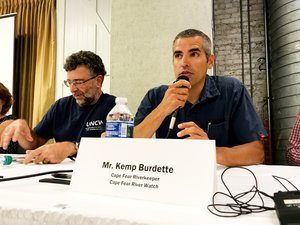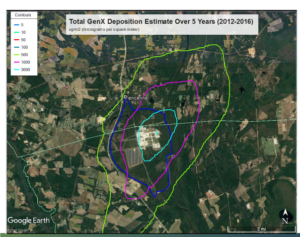It all began on June 7, 2017, when the Star News published an article by independent reporter Vaughn Hagerty called, “Toxin Taints CFPUA Drinking Water,” which referenced a 2016 study about some questionable compounds some scientists found in the river. Hagerty later said he had no idea it would illicit such a firestorm of community outrage. The firestorm continues.

Chemours, and parent company, DuPont, have been discharging unregulated contaminants from their Fayetteville Works facility, into the drinking water supply for about 250,000 people in the Cape Fear region since about 1980.
These compounds are found to be toxic in animal studies; no human studies have been completed, but Cape Fear River Watch worked with NC State to on the first GenX Health Exposure study and collected nearly 400 samples of blood and urine form residents in New Hanover County. Scientists are analyzing the samples now.
What’s in the Water?
The 2016 paper, published by lead author Dr. Detlaf Knappe from NC State, reported on 10 “legacy” and seven recently-discovered compounds in the family of per- and polyfluoroalkyl substances (PFASs) found in the Cape Fear River. Our utility treatment facilities are not able to filter these compounds.
“GenX” was a name given by DuPont to the compound they created to replace C8 in their manufacture of Teflon and related products. The other PFASs don’t have flashy names, but some have been consistently found at higher concentrations than GenX and some may be more dangerous to our health than GenX.
Last fall, the EPA discovered two more compounds being discharged from the Chemours facility from a different manufacturing process, which they named Nafion Byproducts 1 and 2, and which toxicologists consider possibly more toxic than GenX and the related PFASs initially found.
There may be more. It’s hard for scientists to find these unregulated, ‘emerging contaminants’, without expensive, time-consuming research.
Why it’s a Clean Water Matter
GenX and its friends are similar in make-up to C8. The EPA has established a Lifetime Health Advisory limit of 70 parts per trillion (ppt) for C8 due to the fact that studies indicate that exposure to this type of compound may result in adverse health effects, including developmental effects to fetuses during pregnancy or to breastfed infants (e.g., low birth weight, accelerated puberty, skeletal variations), cancer (e.g., testicular, kidney), liver effects (e.g., tissue damage), immune effects (e.g., antibody production and immunity), thyroid effects and other effects (e.g., cholesterol changes). The Lifetime Health Advisory limit is NOT regulatory or enforceable by law.
Moreover, industries are required, under the Toxic Control Substances Act (TSCA), to file reports to the EPA if they find “unreasonable risk to health or to the environment” through their own research on unregulated compounds they manufacture. Chemours and DuPont filed 26 such reports on GenX alone.
There is NO EPA advisory limit on GenX, the Nafion byproducts or the other PFAS contaminants of concern that have been found by scientists.
On July 14, 2017, North Carolina’s Dpt. of Health and Human Services (DHHS) set a “Risk Assessment for GenX” (GenX only), of 140 parts per trillion. This is not regulatory or enforceable by law.
There are no risk assessments set for any of the other compounds.
Groundwater & Soil
The NC Dpt. of Environmental Quality (DEQ) has so far found 115 wells up to 3 miles around the facility that have GenX in concentrations that exceed the DHHS risk assessment level. The testing radius will continue to expand until no wells are found that exceed the DHHS risk assessment level.
Chemours is required to provide these residents with bottled water. (There is a tent at the facility where residents must drive and pick up bottles of water, unassisted.)
DEQ has determined that soil around the plant is likely contaminated, and with rain events, is running off into the river.

Air
After sampling indicated that contamination is occurring upstream of the plant, it was determined that GenX is also being emitted by air. A compound called dimer acid is what is being released through the Chemours air stacks; once this compound hits water, it immediately transforms into GenX.
We don’t yet know what other compounds may be traveling by air.

Why Did DEQ Not Limit Discharge Through Wastewater and Air Quality Permits?
Simply put, the system is broken..
1). State laws need to be amended to prohibit permitted facilities from discharging toxic substances that do not yet have a regulatory standard set by the EPA or the state.
2). NC state law limits the legislature from setting environmental regulations that are more environmentally protective than federal regulations.
3). Another state law (G.S. 143-213(9)) limits DEQ’s authority to regulate air emissions that pollute state waters due to the state’s definition of “discharge,” which currently excludes “emission[s].”
Wastewater Discharge Stopped – For Now
As of November 30, 2017, as ordered by DEQ’s Notice of Partial Suspension, Chemours sent written consent that they would: 1). Continue to prevent Chemours’ discharge of all GenX compounds into the Cape Fear River; 2). By September 8, 2017, cease Chemours’ discharge into the Cape Fear River of the
chemicals identified by the EPA as Nafion byproducts and 1 and 2; and 3). By October 20, 2017, cease Chemours’ discharge into the Cape Fear River of any other perfluorinated or polyfluorinated compound without an effluent limit in the permit.
This is not permanent. The wastewater permit expired, but is, ‘administratively continued until new permit is issued.” DEQ cannot add these unregulated contaminants to the permit. So, we don’t yet know what the next step is to require Chemours to stop this contamination indefinitely, and ensure no contamination like it never happens again.
Air Emissions Ongoing
Chemours reported to the DEQ that they emit about 500 pounds of dimer acid annually; this forms GenX when it hits water. These emissions are not being captured.
Sampling
- DEQ, UNCW and CFPUA continue to sample untreated and finished water.
- Chemours contractor Parsons continues to sample private wells around the facility.
- DEQ is also sampling rainwater and soil.
- Chemours hired a contractor to conduct air stack tests. DEQ requested ‘split samples’ so one set of samples are being analyzed by the contractor and duplicate samples are being sent to the EPA.
- DEQ is beginning a fish tissue study using samples from Marshwood Lake (near the facility).
Legislation
The legislature has not yet responded to requests from DEQ and DHHS for funding to hire more staff and to purchase the equipment (called a high-resolution mass spectrometer) necessary to test their samples in house.
On October 4, 2017, the state passed HB56 which appropriated $435,000 from the Contingency and Emergency Fund as follows:
- $185,000 to CFPUA to study water treatment technology and for ongoing monitoring of water supplies
- $250,000 to UNCW to sample sediment in the Cape Fear River to determine concentrations of GenX to determine the extent to which it biodegrades over time.
HB189 passed the House. It would provide $2.3 million to the NC Dpt. of Environmental Quality to purchase necessary equipment to test water in-house; and requires DEQ conduct several studies. It does not provide recurring funds for staff. (Legislative cuts to the agency’s budget beginning in 2009 have led to a two-year backlog on some wastewater permits. Details about DEQ budget cuts were published by Robin Smith, who served as the agency’s Assistant Secretary for 12 years Robin Smith, at her online publication.)
HB189 Senate Substitute of above. It does not provide recurring funds for DEQ to hire needed staff, nor does it appropriate funds to allow DEQ to purchase necessary equipment to test water in-house; but directs DEQ and DHHS to work with universities on the issue, and provides funding to the UNC Chapel Hill Collaboratory to manage this collaboration. It calls for an EPA audit of DEQ and a review of the permitting program. It requires DEQ set up a collaboration with neighboring states to share information on emerging contaminants. It provides $2.4 million to DEQ to implement the act.
For Cape Fear River Watch’s response to the above senate legislation, read this Feb. 3, 2018 op-ed by Cape Fear Riverkeeper Kemp Burdette and Southern Environmental Law’s Executive Director Derb Carter.

